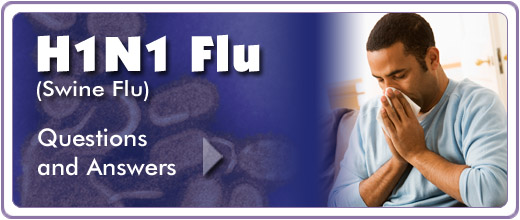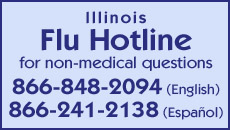
| Business |
H1N1 Flu Home |
Research has shown that one of the most powerful weapons against the spread of respiratory illness, including any strain of influenza, is simply improving hand hygiene. The following steps are recommended to prevent transmission of disease in the work place. Explore this swine flu site or visit www.cdc.gov/swineflu/ for additional information.
Keep the work environment clean and make sure cleaning supplies are available.
- Clean frequently touched surfaces, including door knobs and stair rails, and commonly shared items at least daily and when visibly soiled.
- Use an Environmental Protection Agency (EPA)-registered disinfectant labeled for activity against bacteria and viruses or a bleach solution. Always follow label instructions. If bleach solution is used, mix ¼ cup chlorine bleach with 1 gallon of cool water; prepare fresh solution daily and use within 24 hours.
- Clean shared work areas such as desktops and tables between each shift or more often if possible.
- Discourage sharing of telephones if possible; if sharing is unavoidable telephones should be cleaned between shared use.
- Remind staff to clean their hands (i.e., hand washing with soap and water or use of an alcohol-based hand gel) after cleaning and disinfecting environmental surfaces and items.
Remind staff to clean hands frequently.
- Ensure that restrooms are supplied with soap and paper towels or working hand dryers.
- Advise staff to clean their hands frequently. Staff should wash hands with soap and water frequently and whenever visibly soiled. Alcohol-based hand gels (containing at least 60% alcohol) should be used when soap and water are not available and hands are not visibly dirty. Staff should wash hands before meals and after using the restroom.
- Remind staff that frequent hand cleaning will help protect them from germs. When washing hands, use soap and warm water and wash for 20 seconds. If paper towels are available, use paper towel to turn off the faucet.
Remind staff to cover their noses and mouths when sneezing or coughing.
- If coughing or sneezing, advise staff to use a tissue to cover their nose and mouth or cough or sneeze into their sleeve. Tissues should be discarded in the trash.
- Provide conveniently located trash receptacles so that used tissues can be promptly discarded.
- Encourage staff to wash their hands or use an alcohol-based hand gel as soon as possible, if they have sneezed or coughed on their hands. Hands also should be cleaned after using tissues.
- Post the “Cover Your Cough” poster in restrooms, break rooms and work areas as a visual reminder of appropriate hygiene practices.
H1N1 Flu Resources for Businesses and Employers
Stopping Germs at Home, Work and School - CDC |
|
|

www.flu.gov
U.S. Department of
Health & Human Services’
influenza Web site
| Illinois H1N1 Flu Case Summary |
| Counties |
Confirmed and Probable Cases |
Deaths |
| 42 |
3,425 |
17 |
Illinois Cases of H1N1 Flu by County
(As of July 31, 2009, 10 a.m.)
Updated on Fridays |
City or
County |
# of
Probable Cases |
# of
Confirmed Cases |
Total |
| Boone |
- |
10 |
10 |
| Champaign |
- |
1 |
1 |
| Chicago |
9 |
1,574 |
1,583 |
| Coles |
- |
1 |
1 |
| Cook |
17 |
972 |
989 |
| DeKalb |
- |
2 |
2 |
| DeWitt |
- |
1 |
1 |
| DuPage |
- |
147 |
147 |
| Effingham |
- |
2 |
2 |
| Fayette |
- |
1 |
1 |
| Franklin |
- |
2 |
2 |
| Grundy |
- |
2 |
2 |
| Henry |
- |
2 |
2 |
| Jackson |
- |
1 |
1 |
| Jo Daviess |
- |
1 |
1 |
| Kane |
5 |
86 |
91 |
| Kankakee |
1 |
28 |
29 |
| Kendall |
- |
6 |
6 |
| Knox |
- |
3 |
3 |
| Lake |
5 |
249 |
254 |
| LaSalle |
- |
8 |
8 |
| Madison |
- |
5 |
5 |
| McDonough |
- |
3 |
3 |
| McHenry |
- |
14 |
14 |
| McLean |
- |
2 |
2 |
| Mercer |
1 |
2 |
3 |
| Monroe |
- |
1 |
1 |
| Ogle |
- |
4 |
4 |
| Peoria |
- |
3 |
3 |
| Piatt |
- |
1 |
1 |
| Putnam |
- |
1 |
1 |
| Richland |
- |
2 |
2 |
| Rock Island |
- |
24 |
24 |
| Sangamon |
- |
3 |
3 |
| St. Clair |
- |
4 |
4 |
| Stephenson |
- |
3 |
3 |
| Tazewell |
- |
1 |
1 |
| Union |
- |
1 |
1 |
| Warren |
- |
2 |
2 |
| Whiteside |
- |
2 |
2 |
| Will |
- |
152 |
152 |
| Williamson |
- |
5 |
5 |
| Winnebago |
- |
47 |
47 |
| Undetermined |
- |
6 |
6 |
| Total |
38 |
3,387 |
3,425 |
Locations may change as the result of additional information obtained through case investigations.
A confirmed case is defined as a person with an acute febrile respiratory illness with laboratory confirmed infection.
A probable case is defined as a person with an acute febrile respiratory illness who is positive for influenza A, but negative for H1 and H3.
The reported number of " probable and confirmed" cases do not reflect the overall incidence of H1N1 influenza in Illinois because CDC and the Illinois Department of Public Health are not emphasizing testing of patients with mild illness. Most individuals with novel influenza H1N1 infection have mild illness and are not being tested.
Since the number of Illinois cases listed represent a weekly update, the totals may not always be consistent with those reported by local health departments. If there is a discrepancy between the state and local health department counts, data from the local health departments should be used as the most accurate number.
|

|
|


